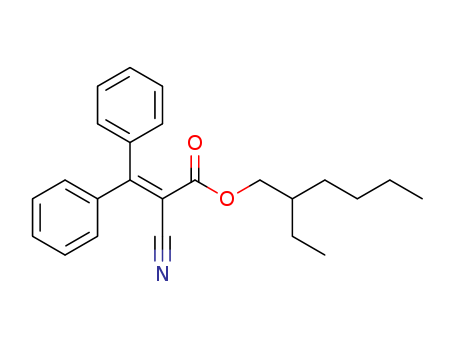
CasNo: 6197-30-4
Molecular Formula: C24H27NO2
Appearance: Yellow viscous liquid
|
benefits |
Octocrylene is a compound often used as an additive in sun screen, and is thought to have skin moisturizing effects because of its emollient properties. What makes this chemical such a popular additive to sun block, is its ability to neutralize UV radiation dissipated by sunlight, and to minimize skin damage from prolonged sun exposure. Octocrylene protects the skin from the harmful effects of the sun and premature skin aging. It helps prevent the risk of skin cancer. This filter mainly absorbs UVB rays, and shorter UVA rays, which are responsible for aging but also for skin cancer. |
|
Air & Water Reactions |
Insoluble in water. |
|
Reactivity Profile |
Octocrilene is an ester derivative. Esters react with acids to liberate heat along with alcohols and acids. Strong oxidizing acids may cause a vigorous reaction that is sufficiently exothermic to ignite the reaction products. Heat is also generated by the interaction of esters with caustic solutions. Flammable hydrogen is generated by mixing esters with alkali metals and hydrides. |
|
Fire Hazard |
Flash point data for Octocrilene are not available. Octocrilene is probably combustible. |
|
Flammability and Explosibility |
Nonflammable |
|
Contact allergens |
Octocrylene is an anti-UVB filter used in cosmetics that may induce photoallergic contact dermatitis. |
|
Side effects |
Some people are concerned about the body’s ability to absorb octocrylene, which can present in the blood, urine, and breast milk. It may promote the production of free radicals, which can damage DNA, potentially increasing the risk of melanoma. However, further research is necessary.People with sensitive skin or skin conditions, such as eczema, may prefer to avoid products containing octocrylene. Alternatively, a person can perform a patch test before using a product containing octocrylene for the first time. The patch test should indicate if an individual is allergic or sensitive to an ingredient in the product.The Food and Drug Administration (FDA) evaluated the safety of octocrylene for use in sunscreen products and found that concentrations of up to 10% are safe.The European Scientific Committee on Consumer Safety (SCCS) also stated that octocrylene is safe in products containing concentrations of no more than 10%.Berardesca, E.,et al.(2019). Review of the safety of octocrylene used as an ultraviolet filter in cosmetics.https://onlinelibrary.wiley.com/doi/full/10.1111/jdv.15945 |
|
Safety Profile |
Low toxicity by ingestion. Whenheated to decomposition it emits toxic vapors of NOx. |
|
|
|
|
Definition |
ChEBI: Octocrylene is a diarylmethane. It is an ester formed by the condensation of a diphenylcyanoacrylate with 2-ethylhexanol, used in sunscreens and cosmetics. |
|
Application |
octocrylene is a uVB sunscreen with strong water-resistant properties and a rather broad-band absorption range. It exhibits good photostability, and is being evaluated by many companies as an effective SPF booster and waterproofing enhancer. This is an expensive ingredient with an approved usage level of 7 to 10 percent in both the united States and the european union. Although gaining in popularity among formulators, its cost and usage level can limit use. In addition, some studies are indicating it may cause allergic reactions in skin with a history of photoallergy. |
|
General Description |
Yellow viscous liquid. Insoluble in water. |
InChI:InChI=1/C24H27NO2/c1-3-5-12-19(4-2)18-27-24(26)22(17-25)23(20-13-8-6-9-14-20)21-15-10-7-11-16-21/h6-11,13-16,19H,3-5,12,18H2,1-2H3
The invention provides a preparation met...
Suggested is a cosmetic and/or pharmaceu...
The present invention relates to a novel...
Suggested is a cosmetic compositions com...
benzophenone

2'-ethylhexyl cyanoacetate

octocrylene
| Conditions | Yield |
|---|---|
|
With ammonium acetate; acetic acid; In water; at 85 - 90 ℃; for 16h; under 400 - 420 Torr; Reagent/catalyst;
|
76.3% |
|
With propionic acid; ammonium acetate; In n-heptane; at 110 ℃; for 5h; under 760.051 Torr; Product distribution / selectivity;
|
66.18% |
2-Ethylhexyl alcohol

etocrylene

octocrylene
| Conditions | Yield |
|---|---|
|
In sodium carbonate;
|
99.8% |
|
With sodium methylate; In toluene; for 8h; Reflux;
|
144.3 g |
2-Ethylhexyl alcohol
etocrylene
benzophenone
2'-ethylhexyl cyanoacetate
etocrylene
2-cyano-3,3-diphenylacrylic acid